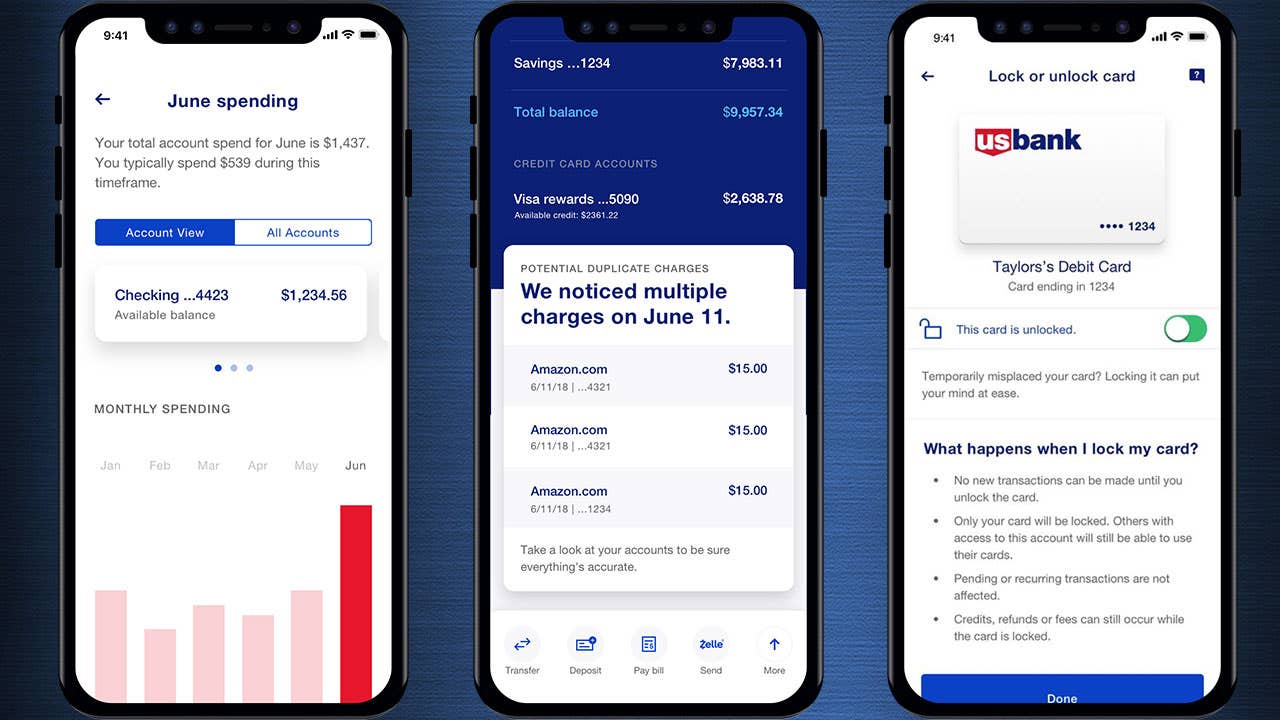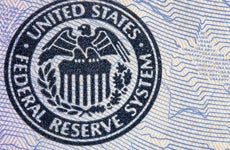Best mobile banking features of 2024

The Bankrate promise
At Bankrate we strive to help you make smarter financial decisions. While we adhere to strict , this post may contain references to products from our partners. Here's an explanation for .
Key takeaways
- Mobile banking has become increasingly popular, with 87% of consumers using their mobile banking app at least once a month.
- Mobile banking apps are now offering advanced features like expense tracking, digital wallet integration, and increased financial security and transparency.
- There are still areas of improvement in the mobile banking sphere, such as personalization and accessibility for financially vulnerable individuals.
If a mobile banking app makes you think of depositing checks and discovering your balance quickly, you’re in good company. These are classic tasks.
But a growing number of banks are adding features to their mobile apps that go beyond the basics — including helping you avoid unwanted charges and track your spending habits. These features might be crucial to customers’ lives at a time when most consumers are struggling to save.
Here’s what you need to know about what you can get from a mobile bank app today, and what to expect next.
Mobile banking statistics
- A vast majority (87 percent) of consumers use their mobile banking app at least once a month. (Chase)
- The mobile banking feature that increased the most in usage over the past year is one that can help customers request a card replacement — 54 percent of customers use this feature, a 5 percent increase since a year ago. (Chase)
- Nearly half (48 percent) of consumers report that using a mobile device is their top option for managing their bank accounts. (American Bankers Association)
- Mobile banking is most preferred among Gen Zers (57 percent) and millennials (60 percent). (ABA)
- As a primary method for accessing bank accounts, mobile banking is more likely to be used by those with some college or a college degree than by those with no college experience. (FDIC)
- Mobile banking also had the highest reported usage for households with higher incomes. (FDIC)
Most important mobile banking features
Expense tracker to show spending and savings patterns
In Bankrate’s recent emergency savings report, it was found that only 44 percent of consumers surveyed would cover an emergency expense of $1,000 or more with savings. Many consumers are struggling to stay on top of their finances and avoid going into more debt.
Banks know we’re in a precarious setup — institutions regularly ask for our feedback and they see our transaction data. They know where we spend our money, how much we make, what kind of bills we have and much more. They also know that they have an opportunity to supply us suggestions about what to do through their mobile apps.
A few ways mobile banking apps can help us track expenses include:
- Alerts for upcoming bills and charges
- Notify when a check clears
- Provide up-to-date account balance information
- Suggestions for when customers can make transfers to savings
- Changes in recurring payments.
“Customers really expect financial services firms to leverage what we know about them and anticipate their needs — so it helps them better manage their finances moving forward,” says Ankit Bhatt, chief digital executive at U.S. Bank.
Many institutions are now offering predictive tools that help customers manage their spending. Huntington Bank launched a digital banking feature called Heads Up that predicts what a customer can afford to spend, when a merchant mistakenly double charges your card and more. Bank of America’s virtual assistant, Erica, now flags customers when a recurring charge or membership fee increases.
Digital wallet integration
Digital wallets are increasingly becoming a norm as more retailers adopt cashless payment methods. According to a recent survey from Banked, almost 60 percent of consumers have used a digital wallet in the past month.
A digital wallet might be provided by a bank, a smartphone manufacturer or a third-party service. It allows consumers to store money digitally and make payments using their smartphones, and it helps them avoid fees, since there’s generally no fee for sending money to someone using a digital wallet. Some common examples include:
- Apple Pay: Available for Apple devices, Apple Pay allows users to make contactless payments within apps, stores or online by linking credit or debit cards.
- Google Pay: Similarly, Google Pay allows for contactless payments, but it’s compatible with Android devices and can be integrated with Google services.
- Zelle: Zelle is included in over 2,000 banks’ mobile apps as a way for individuals to send money to one another, directly from bank account to bank account.
- PayPal: PayPal allows users to link bank accounts, credit/debit cards and even store money within a PayPal account. It supports online payments, money transfers and serves as a payment option for many online stores.
While many popular digital wallets aren’t directly provided by banks, banks can make digital wallets more accessible for consumers by making their bank accounts compatible with digital wallets or even integrating third-party services into mobile banking apps.
While digital wallets make it a lot easier to pay for things, they also potentially make it easier to get scammed. In many cases, you only need a phone number or email to verify who you’re sending money to, so make sure you only send money and make payments to trusted recipients.
Increase in financial security and transparency
With all of the subscriptions, apps, services and accounts we’re linked to, it’s easy to lose track of where your information is going, what it’s used for and how you’re being charged. But mobile banking apps can help organize that information and track it for you.
Wells Fargo, for example, offers a number of features through its app that give customers more control over their bank information and provide recommendations to boost security. Users can track recurring payments (like subscriptions), linked accounts and which devices your cards are connected to.
Many banking apps additionally offer insights into where your data is being shared. With the Bank of America app, for example, customers can see which third parties have access to their data in the Security Center tab. Greater transparency around how their data is stored and used can allow customers to look out for anything suspicious, and it can build trust between customers and their banks.
Prioritize your savings goals
Many consumers are concerned with their level of savings. According to Bankrate’s emergency savings report, 66 percent of people are worried they wouldn’t be able to cover one month of living expenses with their savings if they lost their primary source of income. Without adequate savings, many consumers have to rely on credit cards, loans and other forms of debt that could set back their finances for the long run.
A number of banks are now offering mobile tools that can help you save and mitigate financial insecurity. Ally Bank’s app, for example, has a Surprise Savings feature that analyzes your checking account and spending history and automatically transfers a specified amount that it deems safe-to-save into a savings account.
Other banking apps, such as Varo’s, boost savings by rounding up change from transactions and moving that amount into a savings account. Varo’s app also allows customers to choose a percentage of their direct deposit to be moved into their savings account each month.
Access and redeem rewards points
Though banks offering cash back and other rewards for using their debit and credit cards is nothing new, the integration of rewards in mobile apps offers a sleeker and easier opportunity to earn rewards.
Bank of America, for example, now offers a whole platform within its mobile app dedicated to cash back rewards called BankAmeriDeals. In the app, users can browse through all of the stores and deals that are eligible for cash back rewards when they pay with a BofA debit or credit card. That makes it easy for customers to quickly look at what rewards they’re eligible for when they’re already out and about shopping, so they can maximize their cash back. The app also lets users view all of the cash back rewards they’ve earned.
Other banks may offer points that are earned when you spend on certain purchases, which can be redeemed in a mobile app. U.S. Bank is one bank that’s made it easy for customers to redeem points whenever and wherever they like. Customers simply open the bank’s mobile app and can navigate to a rewards tab, where points can be redeemed for credit, merchandise, gift cards, travel and more.
Manage your cards
Traditional methods of handling lost or stolen debit cards often involve a cumbersome process of calling the bank, waiting in queues and dealing with paperwork. With mobile banking apps, users can instantly lock their cards and protect their money with a few taps.
The instant card lock feature allows users to temporarily disable their debit cards in case of misplaced or stolen cards, suspicious transactions or even as a precaution during travel. The process is simple, typically done by logging into the mobile banking app and selecting the option to lock the card.
In situations where the card is later found or the concern is resolved, users can just as easily unlock their card with the same speed.
The card lock feature can be especially useful for parents who want to give their children some financial control. In case their child loses the debit card, parents can quickly lock it to prevent any misuse.
What’s next in mobile banking?
Expect your mobile banking app to only get better at helping you handle your money as partnerships with fintech companies are made and mobile releases continue to regularly drop.
In J.D. Power’s most recent U.S. Banking Mobile App Satisfaction study, it was found that while basic mobile banking features score high for satisfaction, more advanced features are lagging behind in providing customers with adequate services. These features — such as predictive analyses and budgeting tools — have room for improvement in the mobile banking sphere.
Another noticeable gap in mobile banking is that it’s not accessible to everyone. The FDIC’s How America Banks survey found that households with higher income, as well as those with higher education credentials, are more likely to use mobile banking. Banking technology may evolve to address the needs of those who don’t have as much income or educational resources.
Bear in mind, it’s a vast playing field out there — every bank’s app has its own variation on features offered. The best mobile bank apps are driving new innovations in digital banking. What a bank offers through its app can greatly influence where someone decides to bank, since these apps have become closely tied to helping you save and managing your money overall.
Related Articles



